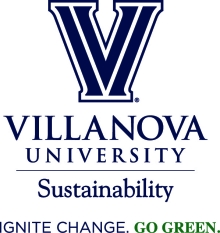Energy and Climate
Carbon Neutrality
Villanova committed to becoming carbon neutral by 2050 after signing the Presidents' Climate Commitment. To learn more about this visit the commitment tab.
Renewable Energy
Power Purchase Agreement
Villanova University entered a power purchase agreement on January 1, 2023, to supply 100% of the electricity for Villanova’s campus from wind farms in Indiana. This contract will continue until the end of 2026.
Solar Power
Villanova has two solar array installations on campus.
- Drosdick Hall, the home of the College of Engineering, has a 4.2 kW array on the roof, that is used as an educational demonstration for the Department of Electrical and Computer Engineering.
- Delurey Hall, an 80-bed dorm on the southwestern edge of main campus, has a 29.1 kW array on the roof. The power is delivered into the University’s electrical distribution system, directly reducing power drawn from the local PECO distribution system.
Geothermal Energy
Villanova installed a geothermal system in Fedegan Hall to help reduce the building’s dependency on electrically-generated heating and cooling. Geothermal systems use the constant temperature of the earth’s crust to cool air in the summer time, and warm air in the winter time.
Energy Efficiency
Much of what Villanova does to be energy efficient can be found in the buildings operations tab, including LEED building design, lighting retrofits, and retro-commissioning. Additionally, Villanova is exploring non-technical means of increasing energy efficiency through scheduling and behavioral change. To learn more about how you can positively impact your buildings energy use click on the housing tab.
Demand Response
The Demand Response program helps keep the power grid from over loading on hot summer days when power is most needed. This program is extremely important in keeping area electric prices down. Without programs like this, electric suppliers would have to build additional power generator plants to meet the few peak energy demand days. By reducing the demand on the system, electricity generating companies are able to avoid that added expense, saving them money, which they are able to pass along to the customers. What’s more, a new power plant would mean more pollution affecting the most vulnerable among us, children, and the elderly.
Villanova is doing its part to help mitigate this outcome by participating in the Demand Response program. Our participation also helps reach our goal of carbon neutrality. To help the University reach carbon neutrality and reduce the frequency of shut down days, you can help by:
- Turning off appliances, such as your computer, fan, and space heater when they are not in use.
- Making sure the lights are turned off when you leave a room.
- Unplugging chargers when they are not being used.
- Getting rid of unnecessary appliances, such as personal refrigerators, microwaves or coffee makers. If you have a communal refrigerator or microwave use that instead. And for coffee, if you want to use your favorite blend bring in a coffee press, they don’t use any energy, just add hot water.
For more ideas on how you can help check out the housing tab.


